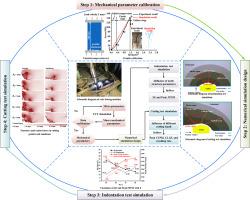Modeling hard rock breakage behavior influenced by the tipped hob cutter's tooth structure using the 2D discrete element (DE) model
IF 4.5
2区 工程技术
Q2 ENGINEERING, CHEMICAL
引用次数: 0
Abstract
A deep understanding of the mesoscopic damage evolution mechanism of tipped hob cutter in hard rock, as influenced by tooth structure parameters and working parameters, can assist in optimizing the tooth of tipped hob cutter and uncovering the failure conditions and mechanism of rock. In this paper, a series of numerical simulations of rock breaking by tipped hob cutter's tooth were modelled, calibrated, and analyzed to investigate the failure conditions and mechanism of rock by tipped hob cutter, as well as the effects of tooth profiles and working parameters on the fracture evolution of hard rock. The results show that the most efficient combination of tooth profile and Dp differs depending on the rock types. D-type teeth with a penetration depth of Dp = 3 mm are optimal for crushing granite, while A-type teeth with a penetration depth of Dp = 4 mm are suitable for crushing sandstone.

使用二维离散元素 (DE) 模型模拟受刀齿结构影响的硬岩破碎行为
深入了解滚刀齿结构参数和工作参数对滚刀齿在硬岩中的中观破坏演化机理的影响,有助于优化滚刀齿,揭示岩石的破坏条件和机理。本文对滚刀齿破碎岩石的一系列数值模拟进行了建模、校准和分析,以研究滚刀齿破碎岩石的条件和机理,以及齿形和工作参数对硬岩断裂演化的影响。结果表明,齿形和 Dp 的最有效组合因岩石类型而异。穿透深度为 Dp = 3 毫米的 D 型齿最适合破碎花岗岩,而穿透深度为 Dp = 4 毫米的 A 型齿适合破碎砂岩。
本文章由计算机程序翻译,如有差异,请以英文原文为准。
求助全文
约1分钟内获得全文
求助全文
来源期刊

Powder Technology
工程技术-工程:化工
CiteScore
9.90
自引率
15.40%
发文量
1047
审稿时长
46 days
期刊介绍:
Powder Technology is an International Journal on the Science and Technology of Wet and Dry Particulate Systems. Powder Technology publishes papers on all aspects of the formation of particles and their characterisation and on the study of systems containing particulate solids. No limitation is imposed on the size of the particles, which may range from nanometre scale, as in pigments or aerosols, to that of mined or quarried materials. The following list of topics is not intended to be comprehensive, but rather to indicate typical subjects which fall within the scope of the journal's interests:
Formation and synthesis of particles by precipitation and other methods.
Modification of particles by agglomeration, coating, comminution and attrition.
Characterisation of the size, shape, surface area, pore structure and strength of particles and agglomerates (including the origins and effects of inter particle forces).
Packing, failure, flow and permeability of assemblies of particles.
Particle-particle interactions and suspension rheology.
Handling and processing operations such as slurry flow, fluidization, pneumatic conveying.
Interactions between particles and their environment, including delivery of particulate products to the body.
Applications of particle technology in production of pharmaceuticals, chemicals, foods, pigments, structural, and functional materials and in environmental and energy related matters.
For materials-oriented contributions we are looking for articles revealing the effect of particle/powder characteristics (size, morphology and composition, in that order) on material performance or functionality and, ideally, comparison to any industrial standard.
 求助内容:
求助内容: 应助结果提醒方式:
应助结果提醒方式:


